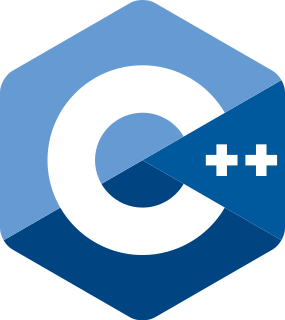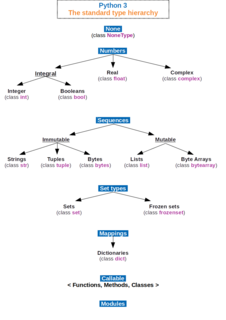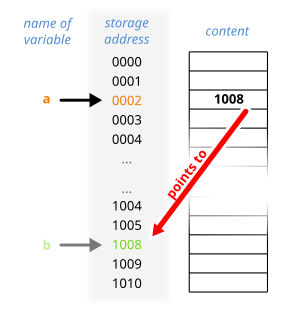In computer science, syntactic sugar is syntax within a programming language that is designed to make things easier to read or to express. It makes the language "sweeter" for human use: things can be expressed more clearly, more concisely, or in an alternative style that some may prefer.

C++ is a general-purpose programming language created by Bjarne Stroustrup as an extension of the C programming language, or "C with Classes". The language has expanded significantly over time, and modern C++ now has object-oriented, generic, and functional features in addition to facilities for low-level memory manipulation. It is almost always implemented as a compiled language, and many vendors provide C++ compilers, including the Free Software Foundation, LLVM, Microsoft, Intel, Oracle, and IBM, so it is available on many platforms.

In computer science and computer programming, a data type or simply type is an attribute of data which tells the compiler or interpreter how the programmer intends to use the data. Most programming languages support basic data types of integer numbers, floating-point numbers, characters and Booleans. A data type constrains the values that an expression, such as a variable or a function, might take. This data type defines the operations that can be done on the data, the meaning of the data, and the way values of that type can be stored. A data type provides a set of values from which an expression may take its values.
In computer programming, a parameter or a formal argument is a special kind of variable used in a subroutine to refer to one of the pieces of data provided as input to the subroutine. These pieces of data are the values of the arguments with which the subroutine is going to be called/invoked. An ordered list of parameters is usually included in the definition of a subroutine, so that, each time the subroutine is called, its arguments for that call are evaluated, and the resulting values can be assigned to the corresponding parameters.
In computer programming, an assignment statement sets and/or re-sets the value stored in the storage location(s) denoted by a variable name; in other words, it copies a value into the variable. In most imperative programming languages, the assignment statement is a fundamental construct.

In computer science, a pointer is an object in many programming languages that stores a memory address. This can be that of another value located in computer memory, or in some cases, that of memory-mapped computer hardware. A pointer references a location in memory, and obtaining the value stored at that location is known as dereferencing the pointer. As an analogy, a page number in a book's index could be considered a pointer to the corresponding page; dereferencing such a pointer would be done by flipping to the page with the given page number and reading the text found on that page. The actual format and content of a pointer variable is dependent on the underlying computer architecture.
In computer science, type conversion, type casting, type coercion, and type juggling are different ways of changing an expression from one data type to another. An example would be the conversion of an integer value into a floating point value or its textual representation as a string, and vice versa. Type conversions can take advantage of certain features of type hierarchies or data representations. Two important aspects of a type conversion are whether it happens implicitly (automatically) or explicitly, and whether the underlying data representation is converted from one representation into another, or a given representation is merely reinterpreted as the representation of another data type. In general, both primitive and compound data types can be converted.
This article compares two programming languages: C# with Java. While the focus of this article is mainly the languages and their features, such a comparison will necessarily also consider some features of platforms and libraries. For a more detailed comparison of the platforms, please see Comparison of the Java and .NET platforms.

The syntax of Java refers to the set of rules defining how a Java program is written and interpreted.
In computer science, the Boolean data type is a data type that has one of two possible values which is intended to represent the two truth values of logic and Boolean algebra. It is named after George Boole, who first defined an algebraic system of logic in the mid 19th century. The Boolean data type is primarily associated with conditional statements, which allow different actions by changing control flow depending on whether a programmer-specified Boolean condition evaluates to true or false. It is a special case of a more general logical data type —logic doesn't always need to be Boolean.
C-- is a C-like programming language. Its creators, functional programming researchers Simon Peyton Jones and Norman Ramsey, designed it to be generated mainly by compilers for very high-level languages rather than written by human programmers. Unlike many other intermediate languages, its representation is plain ASCII text, not bytecode or another binary format.

C# is a general-purpose, multi-paradigm programming language encompassing static typing, strong typing, lexically scoped, imperative, declarative, functional, generic, object-oriented (class-based), and component-oriented programming disciplines.
C++11 is a version of the standard for the programming language C++. It was approved by International Organization for Standardization (ISO) on 12 August 2011, replacing C++03, superseded by C++14 on 18 August 2014 and later, by C++17. The name follows the tradition of naming language versions by the publication year of the specification, though it was formerly named C++0x because it was expected to be published before 2010.
Nullable types are a feature of some programming languages which allow the value to be set to the special value NULL instead of the usual possible values of the data type. In statically typed languages, a nullable type is an option type, while in dynamically typed languages, equivalent behavior is provided by having a single null value.
This article describes the syntax of the C# programming language. The features described are compatible with .NET Framework and Mono.
The programming language C# introduces several new features in version 2.0. These include:
Blocks are a non-standard extension added by Apple Inc. to Clang's implementations of the C, C++, and Objective-C programming languages that uses a lambda expression-like syntax to create closures within these languages. Blocks are supported for programs developed for Mac OS X 10.6+ and iOS 4.0+, although third-party runtimes allow use on Mac OS X 10.5 and iOS 2.2+ and non-Apple systems.

Elm is a domain-specific programming language for declaratively creating web browser-based graphical user interfaces. Elm is purely functional, and is developed with emphasis on usability, performance, and robustness. It advertises "no runtime exceptions in practice", made possible by the Elm compiler's static type checking.
Swift is a general-purpose, multi-paradigm, compiled programming language developed by Apple Inc. and the open-source community. First released in 2014, Swift was developed as a replacement for Apple's earlier programming language Objective-C, as Objective-C had been largely unchanged since the early 1980s and lacked modern language features. Swift works with Apple's Cocoa and Cocoa Touch frameworks, and a key aspect of Swift's design was the ability to interoperate with the huge body of existing Objective-C code developed for Apple products over the previous decades. It is built with the open source LLVM compiler framework and has been included in Xcode since version 6, released in 2014. On Apple platforms, it uses the Objective-C runtime library which allows C, Objective-C, C++ and Swift code to run within one program.





